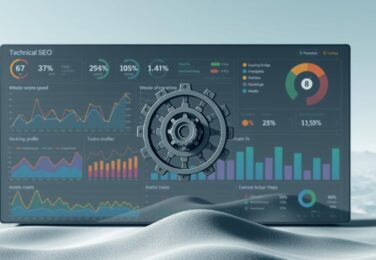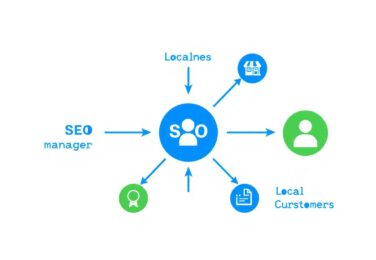How to build your own templates using Lookerstudio

Table of Content
We’re always looking for ways to make data easier to understand and use. Digital storytelling helps us turn complex data into clear, useful insights. At Defyn, we help businesses by solving technical problems, so you can focus on what’s important.
Creating custom templates in Lookerstudio can change the game for businesses. They’re great for tracking campaigns, making financial reports, or showing team progress. If you’re having trouble with SEO or need help with Lookerstudio, contact us at hello@defyn.com.au.
Key Takeaways
- Create custom templates to streamline your workflow
- Enhance data communication with compelling visual narratives
- Transform complex data into actionable insights
- Improve your digital storytelling capabilities
- Get expert support when you need it
What Makes Lookerstudio Essential for Data Visualisation
Lookerstudio has changed how businesses use data visualisation, providing a strong tool for making high-quality visuals. As we deal with the challenges of making decisions based on data, it’s key to know how data reporting tools have evolved. We must also understand what makes Lookerstudio stand out.
The Evolution of Data Reporting Tools
Data visualisation has changed a lot in the last ten years. It has moved from simple charts in spreadsheets to complex interactive dashboards. We’ve seen this change, helping clients move from static reports to dynamic visual platforms. The need for better, more interactive, and informative visualisations has driven these changes.
Key Features That Set Lookerstudio Apart
Lookerstudio’s easy-to-use interface hides its advanced features, making it great for all kinds of businesses. What makes Lookerstudio different from other tools include:
- Seamless integration with many data sources
- Collaborative tools for teams to work better together
- Many customisation options to fit specific business needs
These features, along with its user-friendly interface, make Lookerstudio a must-have for businesses wanting to improve their data visualisation. It helps them make better decisions.
Getting Started with Lookerstudio Basics
As experienced visual creators, we know that getting good at Lookerstudio starts with the basics. Before you start making templates, it’s key to understand the platform’s main features and how they work.
Setting Up Your Lookerstudio Account
Setting up your Lookerstudio account is easy. You just need a Google account to begin. It’s a good idea to set up your account settings first. This includes choosing your language and notification preferences to make your work easier later.
Navigating the Dashboard and Interface
The Lookerstudio dashboard is your main hub. It gives you access to all your reports, data sources, and templates. Knowing how to move around this interface quickly is important, as your collection of templates grows. We show you the key parts and shortcuts that experienced visual creators use every day.
Understanding Template Fundamentals
Understanding the basics of templates is key to good data visualisation in Lookerstudio. We explain how data sources, reports, and templates work together. This knowledge is essential as you move on to more complex template creation.
Planning Your Custom Template Strategy
Before starting on your template design, it’s key to plan well. Think about your reporting goals and what your audience needs. Good template creation starts with careful planning, just like professional photography needs a good setup.
Defining Your Reporting Objectives
To make effective templates, you must have clear goals. Ask yourself: What story do you want to tell with your data? Who will see these reports? What actions should they take based on the insights?
This clarity will help guide your design choices.
Identifying Key Metrics and KPIs
Finding the right metrics and KPIs is vital for telling a story with data. We help you pick between vanity metrics and insights that matter. This ensures your templates show data that helps make business decisions.
This step often involves talking to stakeholders and analysing the business. It makes sure your reports match your company’s goals.
Mapping Your Template Structure
After setting your goals and choosing metrics, it’s time to map your template structure. We show you how to arrange information in a logical order. This makes it easy for users to follow the data story.
This planning might take time, but it saves you from costly changes later. It leads to templates that meet your business needs well.
Step-by-Step Template Creation in Lookerstudio
We’re ready to start making templates in Lookerstudio. This process has several important steps. These steps will help us create templates that look good and work well.
Starting a New Template Project
Starting a new project in Lookerstudio gives us two choices. We can start with a blank page or pick from a template gallery. The blank canvas lets us create from scratch. The template gallery has pre-made templates we can customise.
For beginners, using a gallery template is a good idea. It helps us learn the best practices before we start from scratch.
Blank Canvas vs. Template Gallery Options
Choosing between a blank canvas and a template gallery depends on our skills and project needs. If we know Lookerstudio well and have a clear idea, starting from scratch is best. But, if we’re new or need ideas, the template gallery is perfect.
Setting Initial Parameters
When setting up our template, we need to think about how it will be used. Will it be for regular reports, one-off analyses, or interactive dashboards? This affects our choices, like the types of visuals and how interactive it will be.
Configuring Page Layouts and Dimensions
Setting up page layouts and dimensions is key. We must make sure our reports look good on all devices. Using artistic imagery principles like spacing and alignment helps a lot.
Adding Core Elements to Your Template
Choosing the right elements for our template is important. This includes:
- Charts and Graphs: We pick based on what they show, not just how they look.
- Text Elements and Headers: They help explain our data and guide users.
- Images and Branding Components: These make sure our templates match our brand.
We’ll show how to add these elements in a clean, professional way.
Charts and Graphs
Charts and graphs are vital for showing data. We choose types that fit our data best, like bar charts for comparisons or line graphs for trends.
Text Elements and Headers
Text and headers add context to our visuals. They help users understand our data’s story.
Images and Branding Components
Adding images and branding elements, like logos and colors, keeps our templates consistent with our brand.
Saving and Organising Your Template Files
It’s important to save and organise our template files well. We should use a clear naming system and folder structure. This helps us manage our templates easily.
Connecting Data Sources to Power Your Templates
Lookerstudio’s strength comes from connecting to many data platforms. It’s key to know how to link these sources. Without data, templates are just empty shells. But with the right data, they come alive. We use Lookerstudio for top events coverage, combining real-time data from various sources for dynamic dashboards.
Compatible Data Platforms and Integrations
Lookerstudio works with many data sources, like Google Analytics and Ads, SQL databases, and social media. It also has hundreds of sources through partner connectors. This lets you pick the best data flow for your reports.
- Google Analytics and Ads for marketing insights
- SQL databases for deep data analysis
- Social media for tracking campaigns
- Hundreds of sources through partner connectors
Step-by-Step Data Connection Process
The data connection process in Lookerstudio is straightforward. First, you authenticate your data source for secure access. Next, you set up data refreshing to keep your templates current. Lastly, you map your data fields for accurate and timely information.
- Authenticate your data source
- Configure data refreshing options
- Map your data fields for accurate reporting
Creating Blended Data Sources
For detailed reports, Lookerstudio lets you blend data sources. This feature mixes data from different platforms into one view. For example, you can merge Google Analytics with social media data for a full marketing view.
“Blended data sources in Lookerstudio have revolutionised our approach to data analysis, allowing us to make more informed decisions.” – Data Analyst
Troubleshooting Connection Issues
Even with Lookerstudio’s ease of connection, issues can pop up. Problems like authentication errors, data refresh failures, and field mapping issues can happen. If you face ongoing connection problems, reach out to hello@defyn.com.au for help.
Advanced Customisation Techniques for Professional Templates
Advanced customisation in Lookerstudio is like creative videography. It turns raw data into high-quality visuals. To make your templates stand out, you need to learn advanced techniques. These techniques improve both the usefulness and the look of your templates.
Creating Custom Metrics and Calculated Fields
Creating custom metrics and fields in Lookerstudio goes beyond basic reporting. We use the formula editor to make calculations that show insights not seen in raw data. For example, you can make conversion rates or custom scores that add value to your reports.
| Metric | Description | Formula |
|---|---|---|
| Conversion Rate | Percentage of users who completed a desired action | (Conversions / Total Users) * 100 |
| Custom Score | A weighted score based on multiple KPIs | (Metric1 * 0.3) + (Metric2 * 0.7) |
Implementing Dynamic Date Ranges
Dynamic date ranges make reports more flexible than static ones. They let users look at trends over different times. We use relative date ranges, comparison periods, and custom date selectors to help users explore data on their own.
- Relative Date Ranges: Automatically adjust based on the current date
- Comparison Periods: Allow users to compare current data with past data
- Custom Date Selectors: Enable users to choose specific date ranges
Building Interactive Filtering Controls
Interactive filtering controls turn reports into tools for exploration. We show you how to make dropdown menus, checkboxes, and slider controls. These let users segment data based on their questions.
- Create a dropdown menu to select different product categories
- Use checkboxes to filter data by multiple dimensions
- Implement slider controls to adjust numerical ranges
Adding Conditional Formatting Rules
Conditional formatting rules make reports more intelligent. They highlight important data automatically. We teach you how to use color scales, icons, and rules to focus users on key insights.
| Rule | Description | Formatting |
|---|---|---|
| Threshold Alert | Highlight values above a certain threshold | Red background |
| Trend Indicator | Indicate upward or downward trends | Green for up, red for down |
Designing Visually Compelling Lookerstudio Templates
To make your data visualisations impactful, thoughtful design is key in Lookerstudio. Just as a Melbourne wedding photographer carefully considers composition, lighting, and mood, your template design choices can significantly enhance your data visualisations.
Colour Theory and Palette Selection
Colour theory is vital for both beauty and clarity. We help you pick colour palettes that match your brand and serve specific report purposes. For example, using a consistent colour scheme for similar metrics across reports can boost brand recognition and make your visualisations more intuitive.
Key considerations for colour palette selection include:
- Ensuring sufficient contrast for readability
- Using colours that are accessible to all users, including those with colour vision deficiency
- Limiting the palette to a manageable number of colours to avoid visual clutter
Typography Hierarchy for Clear Communication
Typography hierarchy organises information visually, guiding users through your data narrative. We show how to create clear distinctions between titles, subtitles, annotations, and data labels through thoughtful font selection, sizing, and styling. For example, using a larger font size for titles and a bold style for key metrics can help users quickly scan reports to locate relevant information.
Best practices for typography hierarchy include:
- Using a clear and consistent font throughout the template
- Creating visual distinction between different types of information
- Ensuring that text is legible on various devices and screen sizes
Layout Principles for Effective Data Storytelling
Layout principles for data storytelling draw from artistic concepts but adapt them for data visualisation. We explore the strategic use of white space, alignment grids, and visual grouping to create templates that feel cohesive and intuitive. As noted by a renowned data visualisation expert, “The goal is to make the data tell a story that is easy to understand and act upon.”
“The most effective data visualisations are those that tell a story without overwhelming the viewer.”
Common layout challenges, such as balancing detail with overview perspectives and managing complex multi-metric displays, are also addressed.
Incorporating Your Brand Identity
Incorporating your brand identity transforms generic reports into proprietary business assets. Beyond simply adding logos, we show you how to integrate your brand’s visual language throughout your templates, from colour schemes to custom icons. This consistent branding reinforces organisational identity while maintaining the clarity and functionality essential for effective data communication.
Steps to incorporate brand identity include:
- Using brand-specific colours and typography
- Incorporating custom icons and graphics that align with your brand
- Ensuring that the overall design is consistent with your brand guidelines
Template Organisation and Management Best Practices
Keeping templates organised is vital for a smooth reporting process. We’ve learned this from managing large template collections. As your collection grows, it’s important to keep everything organised for better efficiency and growth.
Creating Template Libraries and Categories
Setting up template libraries with clear categories helps team members find what they need fast. It’s wise to use naming conventions and folder structures that grow with your needs. This setup is key as your reporting needs spread across different departments and uses.
Version Control and Update Procedures
Version control stops the mess that comes from many template versions. We teach you how to track template versions, document changes, and switch between versions smoothly. This is critical for templates used often or by many teams, where keeping things consistent is essential.
Documentation for Team Adoption
Good documentation turns personal knowledge into something everyone can use. We show you how to make template guides that help teams use templates without needing a lot of training. These guides should explain the template’s purpose, what data it needs, how to update it, and how to customise it.
For complex templates, include examples to show how to get insights from them. This supports digital storytelling in your organisation.
By following these best practices, businesses can make their template management efficient and scalable. This supports their growth and reporting needs. As experienced visual creators, we’ve seen how good template management can improve a company’s reporting. It leads to better communication and decision-making.
Sharing and Collaborating on Lookerstudio Templates
Sharing and working together on Lookerstudio templates makes reporting a team effort. It’s like how professional photography for big events needs many experts working together. Knowing how to share and collaborate helps you use everyone’s skills while keeping things secure.

Permission Settings and Access Control
Permission settings let you control who can see, change, or manage your templates. We show you how to set up different permissions and use roles to match your team’s structure. This helps manage who can see what, keeping important info safe.
You can give roles like ‘Viewer’, ‘Editor’, or ‘Manager’ to decide who can do what. For example, ‘Viewer’ can just look but not change anything.
- Viewer: Can view the template but cannot make any changes.
- Editor: Can edit the template but cannot share it with others.
- Manager: Has full control over the template, including sharing and editing.
Collaborative Editing Workflows
Working together on templates lets many people help make them at the same time. We share tips on how to work together well, like talking clearly and managing changes. This is great when you need input from different teams, like marketing and finance.
To work well together, make a clear plan of who does what and when. Regular meetings and updates help keep the project moving forward.
Embedding and Distribution Options
Lookerstudio templates can be shared in many ways, not just on the platform. We show how to put reports on websites, company sites, or presentation tools. You can also send reports automatically by email. This makes sure your reports get to the right people easily.
For reports for clients, we talk about how to make them look like they’re from your company. Using these features can make your reports more useful for your business. Whether you’re sharing with team members or putting reports on your company’s site, Lookerstudio makes it easy to share your data.
Optimising Templates for Different Viewing Contexts
Modern business reporting needs Lookerstudio templates to work well in many places. This includes the boardroom and on mobile devices. It’s important to make sure your templates look good on all devices and screen sizes. This helps keep high-quality visuals and makes data easy to understand.
Responsive Design Principles in Lookerstudio
When making templates in Lookerstudio, using responsive design principles is vital. This means your visuals will look good on any device. You should use elements that change size, put important content first, and use Lookerstudio’s built-in features.
This way, your templates will adjust to different screen sizes and shapes. It makes your work easier to maintain.
Mobile-Friendly Template Considerations
Our experience in creative videography helps us know how to make templates for mobile. We suggest making complex visuals simpler for mobile without losing important details. Use touch-friendly elements, organise information well, and make sure it works smoothly on mobile.
Testing Across Devices and Platforms
To make sure your templates work well everywhere, you need to test them. Check how interactive elements work, make sure data is visible, and test how fast they load on different devices and browsers. For important reports, have a checklist for testing when you deploy your templates.
By following these tips and making your Lookerstudio templates work for different places, your data visualisations will stay impactful. They will work well on the many devices used in today’s business world.
Troubleshooting Common Template Issues
Troubleshooting is key for anyone using Lookerstudio templates. Even experienced visual creators face problems that can slow down templates and disrupt reports.
Fixing Data Refresh Problems
Data refresh issues often hit template performance, mainly with complex data or lots of data. Common problems include:
- Authentication timeouts
- Query limitations
- Caching behaviors
To fix these, check your data source connections, tweak query settings, and adjust caching.
Resolving Layout and Formatting Glitches
Layout and formatting problems can mess up your template’s look. Issues like element alignment, text overflow, and visualisation errors are common. To solve these, try:
- Checking element sizing and positioning
- Adjusting text formatting and wrapping
- Verifying visualisation configurations
Getting Professional Support
At times, you might need help from experts. If you’re stuck with data connection issues, complex errors, or need custom features, our team at hello@defyn.com.au is here to help.
When to Contact Experts
If you’re facing problems you can’t solve or need special help, contact our team for support.
Community Resources for Template Help
The Lookerstudio community has great resources for fixing template problems. You can find official support, user forums, and knowledge bases. These can offer creative solutions to common issues.
Real-World Template Examples and Use Cases
Looking at real-world Lookerstudio templates can teach businesses a lot. It’s like a Melbourne wedding photographer studying great work to get better. By checking out successful templates, you can improve your reporting skills.
Marketing Performance Dashboards
Marketing dashboards are a big deal in Lookerstudio. They track how well marketing campaigns do, from start to finish. They also show how well audiences engage, using artistic imagery to make connections clear.
Financial Reporting Templates
Financial reports need to be right, follow rules, and easy to understand. Good financial templates show how to make complex data simple to see. They keep the important details sharp for making money decisions.
Project Management Visualisations
Lookerstudio is great for more than just marketing and finance. It’s also good for project management. These templates help track project progress, who’s doing what, and how well teams work together. This makes projects clearer and more accountable.

Conclusion
Creating effective templates in Lookerstudio is a smart move. It leads to better reporting, clearer insights, and smarter business choices. You’ve learned how to turn data into a strategic advantage through digital storytelling.
Mastering template creation is like mastering videography. It takes practice and trying new things. Start with simple templates and add more features as you get better. Each version should get better based on feedback and changing needs.
If you hit a roadblock or need help, our team at hello@defyn.com.au is here for you. Spending time on good template design now will help your business make better decisions for years.










